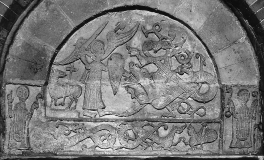
Interpreting 12th-century sculpture in English churches




The tympanum at Southwell Minster

Webb believed that the Southwell Minster tympanum is one of a group of twelfth cenury scultpures representing Christ's descent into Hades for the redemption of mankind¹. The winged figure is not St Michael, but Christ, who has flown down from Heaven to destroy Death, here personified by Leviathan. The stone itself may have been brought in from elsewhere, and may possibly have been a recycled Anglo-Saxon grave monument
This winged figure should be compared with the winged figure of the fighting Christ on the Hoveringham tympanum, where His divine identity is established by the hand of God pointing down on Him ("This is my beloved Son") and by the Lamb of God placed beside Him on a pedestal. At Southwell Minster, the divine identity of Christ is also shown by David, the prototype of Christ², rescuing the lamb from the mouth of the lion.
This group of intriguing carvings illustrated the Alexandrian Ransom Theory as expounded by Gregory in the Moralia in Job. In the Middle Ages it was not uncommon for holy souls to be depicted with wings. Christ himself was depicted not only as a winged man but also sometimes as a bird, a vulture or an eagle: "the dear bird that came down from Heaven". In the Winchester Psalter there is a drawing of the "dear bird" resting in the lap of God the Father.
References to Leviathan:
Who can open the doors of his face? Round about his teeth is terror. His strong scales are his pride, shut up together as with a closed seal. One is so near to another, that no air can come between them. They are joined one to another; they stick together, that they cannot be sundered. (Job 41:14-17).
Gregory comments:
It is said that the body of the dragon is covered with scales to keep it from being penetrated quickly with shafts […] that it may not be transfixed with the arrow of Truth [...] For whoever when reproved seeks to excuse rather than lament, his sin is covered as it were with scales […] when assailed by holy preachers the sword of the Word has no way of reaching his heart.
Other Biblical references to Leviathan, suggesting butchery, were widely known:
Shall friends cut him in pieces, shall merchants divide him? Job 41:6
Thou hast broken the heads of the dragon: thou hast given him to be meat for the people of the Ethiopians. Psalm 74:15
¹ Some date it earlier, noting the tangles in the monster’s tail, in the Ringerike style. (Anglo-Norman Studies XII: Proceedings of the Battle Conference 1989, ed. M Chibnall)
² God’s prototype, or archetype of a prophet, is first mentioned in Genesis 20:7. David is the prophetic prototype of a powerful ruler to descend from him, who will lead God’s people to victory and peace. King David, having been anointed by God as a king and prophet, was the prototype of the Higher King and Prophet — Christ.